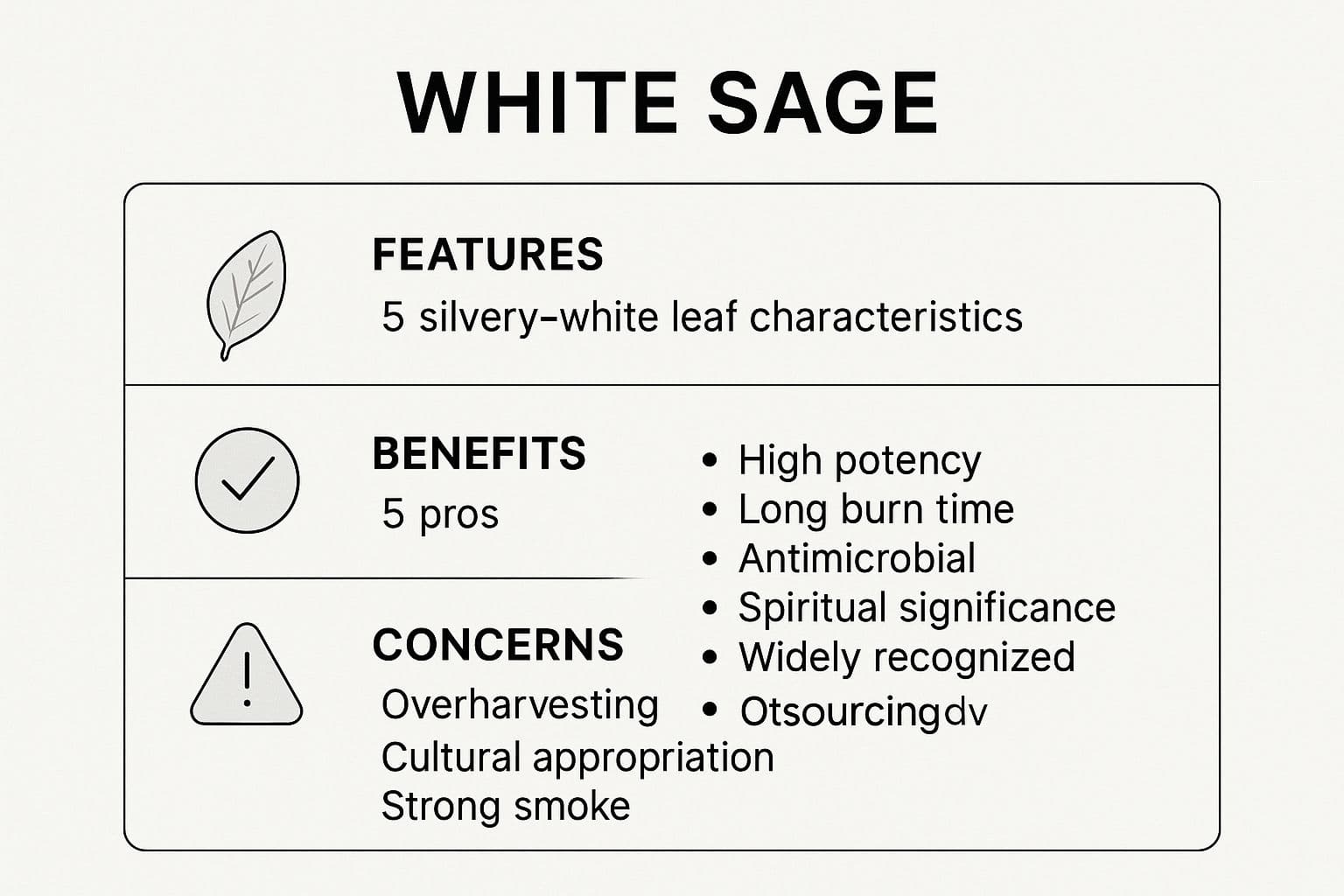Smudging uses burned herbs to cleanse spaces, objects, and personal energy. Choosing the right plant depends on your intention, respect for cultural origins, and sustainability. This guide reviews six widely used smudging herbs, explains when to use each, and offers safety and sourcing tips.
June 30, 2025 (5mo ago) — last updated November 3, 2025 (1mo ago)
6 Best Smudging Herbs: Ethical Guide (2025)
Learn when and how to use six sacred smudging herbs—white sage, palo santo, cedar, sweetgrass, lavender, rosemary—plus ethical sourcing and safety tips.
← Back to blog
6 Best Smudging Herbs: Ethical Guide (2025)
Summary: Discover six sacred herbs for smudging—white sage, palo santo, cedar, sweetgrass, lavender, and rosemary—with ethical sourcing and clear usage guidance.
Introduction
Smudging is the practice of burning sacred plants to create cleansing smoke that purifies spaces, objects, and personal energy. Choosing the right herb depends on your intention, respect for cultural origins, and attention to sustainability1. This guide explains the spiritual properties of six popular smudging herbs, when to use each, how to smudge safely, and how to source plants responsibly.
1. White Sage (Salvia apiana): The Ultimate Purifier
White sage is widely recognized for deep energetic cleansing and is sacred to many Indigenous nations across North America. It’s traditionally used in ceremonies to clear heavy or stagnant energy. Use white sage when you need a profound reset — after illness, conflict, or before important rituals.
When to use white sage
- After illness or conflict to clear lingering emotional residue
- Cleansing a new home or second‑hand item to remove previous imprints
- Before ritual, meditation, or energetic work
- Periodic energetic maintenance to prevent stagnation
Respectful and effective use
Treat white sage as a sacred medicine. A single leaf can cleanse a small room — there’s no need to burn an entire bundle. Open a window to give the smoke a path to exit and always use a fireproof dish for ashes. Because wild populations have been stressed by high demand, prioritize ethically cultivated sage or grow your own when possible1.

Key insight: Smudging with white sage is a sacred act that requires mindfulness, gratitude, and a commitment to honoring its cultural origins.
2. Palo Santo (Bursera graveolens): The Sacred Wood for Healing and Creativity
Palo santo, or “holy wood,” offers a sweet, woody aroma that clears negativity while inviting healing, creativity, and joy. Traditionally used by Incan and Andean healers, its smoke is uplifting and grounding — ideal for creative work, meditation, or a daily energy tune‑up.
When to use palo santo
- To enhance creativity and focus before work or art
- To deepen meditation, prayer, or yoga practice
- For daily energy maintenance, morning or evening
- To seal positive intentions after a stronger cleanse
Respectful and effective use
Only purchase palo santo from vendors that confirm the wood comes from naturally fallen trees and sustainable harvests — overharvesting and illegal logging have been reported in some regions2. Light one end of a stick, let it burn briefly, then blow it out and let the smoke waft through your space. Relight as needed; a single stick can be reused many times.

3. Cedar (Cedrus or Thuja species): The Ancient Protector
Cedar’s warm, woody scent is associated with protection and grounding. Used by many cultures, including Pacific Northwest Indigenous nations, cedar invites benevolent spirits and creates a protective field — making it well suited for blessing homes and daily grounding rituals.
When to use cedar
- To create a protective shield before guests arrive
- For house blessings and establishing safety in a new space
- In daily grounding rituals before meditation or work
- To cleanse sacred objects like crystals or ritual tools
Respectful and effective use
Burn dried foliage on a charcoal disc or use cedar smudge sticks. Choose organic, untreated cedar to avoid inhaling toxins. Even with widely available cedar, honor the plant’s history and use it with intention.
4. Sweetgrass (Hierochloe odorata): Inviting Kindness and Blessings
Sweetgrass, often called the “hair of Mother Earth,” has a sweet, vanilla‑like aroma that invites positive energy and blessings rather than banishing. It’s commonly used after cleansing to call in harmony, kindness, and community.
When to use sweetgrass
- After a cleansing ritual to invite positive vibrations
- To bless a new home and set intentions for peace
- Before meditation or prayer to create a serene atmosphere
- In daily gratitude practices to cultivate joy and appreciation
Respectful and effective use
Sweetgrass is often braided; light the tip and allow it to smolder, using a feather or hand to waft smoke. Source sweetgrass from ethical suppliers who work with Indigenous harvesters or sustainable growers.
5. Lavender (Lavandula angustifolia): The Soothing Harmonizer
Lavender brings a floral, calming scent that soothes anxiety and raises the vibrational frequency of a space. While its use in smudging is more common in European folk traditions, lavender works beautifully for rest, relaxation, and emotional balance.
When to use lavender
- Before sleep to calm a racing mind and encourage rest
- After emotional upset to restore equilibrium
- To enhance meditation and deepen relaxation
- To create a welcoming, peaceful atmosphere in living spaces
Respectful and effective use
Use fully dried lavender to produce clean smoke. Burn loose flowers on a charcoal disc or a small wand. Look for organic, culinary‑grade lavender or grow your own for a sustainable supply.
6. Rosemary (Rosmarinus officinalis): The Herb of Remembrance and Clarity
Rosemary has a stimulating, pine‑like scent tied to memory, clarity, and protection in Mediterranean traditions. It’s an accessible and sustainable option for clearing spaces while sharpening the mind — useful before work, study, or new beginnings4.
When to use rosemary
- Before studying or work to enhance focus and memory
- To break up stagnation and invite fresh energy
- When starting a new project or life phase
- For introspection and self‑awareness exercises
Respectful and effective use
Light dried sprigs and let them smolder, relighting as needed. Rosemary is easy to grow in pots or gardens, making it a sustainable and practical choice.
Quick Comparison
| Herb | Primary Use | Strength | Sustainability notes |
|---|---|---|---|
| White Sage | Deep purification | High | Seek ethically cultivated sources1 |
| Palo Santo | Cleansing and blessing | Medium | Use certified fallen wood2 |
| Cedar | Protection and grounding | Medium | Choose untreated, organic cedar |
| Sweetgrass | Inviting blessings | Low–Medium | Source from ethical harvesters |
| Lavender | Relaxation and harmony | Low | Easy to grow; organic recommended |
| Rosemary | Clarity and memory | Low | Readily grown; sustainable |
How to Smudge Safely and Effectively
- Set a clear intention before you begin. Your mindset guides the ritual.
- Use a fireproof bowl or abalone shell to catch ash and embers. Keep water nearby.
- Ventilate the room by opening a window or door so the smoke has an exit path — this helps move energy out and improves air quality3.
- Move mindfully through your space, guiding smoke into corners, doorways, and around objects you wish to cleanse.
- Extinguish materials completely after use. Store herbs in a dry, cool place.
Key insight: Smudging is a relationship with plants and tradition. Approach each herb with respect for its cultural roots and ecological impact.
Actionable Steps to Build a Respectful Smudging Practice
- Identify your core need — cleansing, protection, blessing, relaxation, or focus.
- Choose the herb that aligns with that intention.
- Source mindfully: support Indigenous‑owned businesses, small‑scale harvesters, or grow your own lavender and rosemary.
- Create a simple, repeatable ritual: light, set intention, waft smoke, and close with gratitude.
For related guidance on clearing your environment, see this resource on removing negative energy from your house: Remove Negative Energy From House.
Common Questions (Q&A)
Q: How often should I smudge my home?
A: Smudge as needed — after conflict, illness, or when a space feels heavy. For routine maintenance, once a month or seasonally works for many people.
Q: Are there health risks to smudging indoors?
A: Burning plant materials produces smoke and particulates. Ventilate the space and avoid overexposure, especially for people with respiratory conditions3.
Q: How can I practice smudging without cultural appropriation?
A: Learn about the plant’s cultural origins, support Indigenous vendors, and use plants respectfully. When in doubt, prioritize ethical sourcing and consider alternatives like lavender or rosemary that don’t carry the same cultural concerns.
Quick Q&A — Fast Answers
Q: Which herb is best for deep cleansing?
A: White sage is most often used for deep purification; use it sparingly and ethically1.
Q: Which option is best for everyday use?
A: Palo santo or lavender are good for daily maintenance and gentle clearing2.
Q: How do I reduce smoke risks?
A: Ventilate, use small amounts, and avoid smudging near people with asthma or other respiratory issues3.
Further Resources and Related Links
- Life Purpose App: lifepurposeapp.com
- Growing rosemary from cuttings: Cultivating Rosemary
- Ways to grow spiritually and support ritual practice: How to Grow Spiritually
Discover Your Life Purpose Today!
Unlock your true potential and find your life’s purpose.
